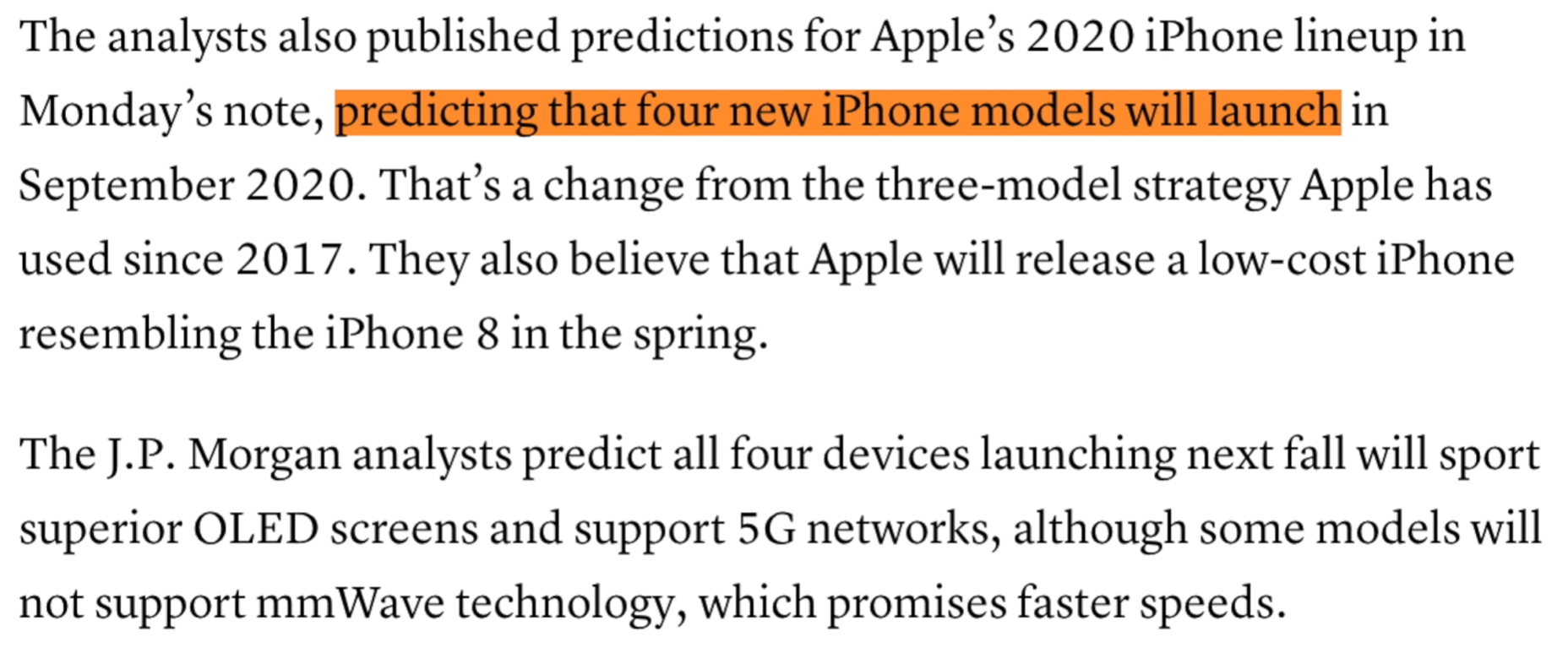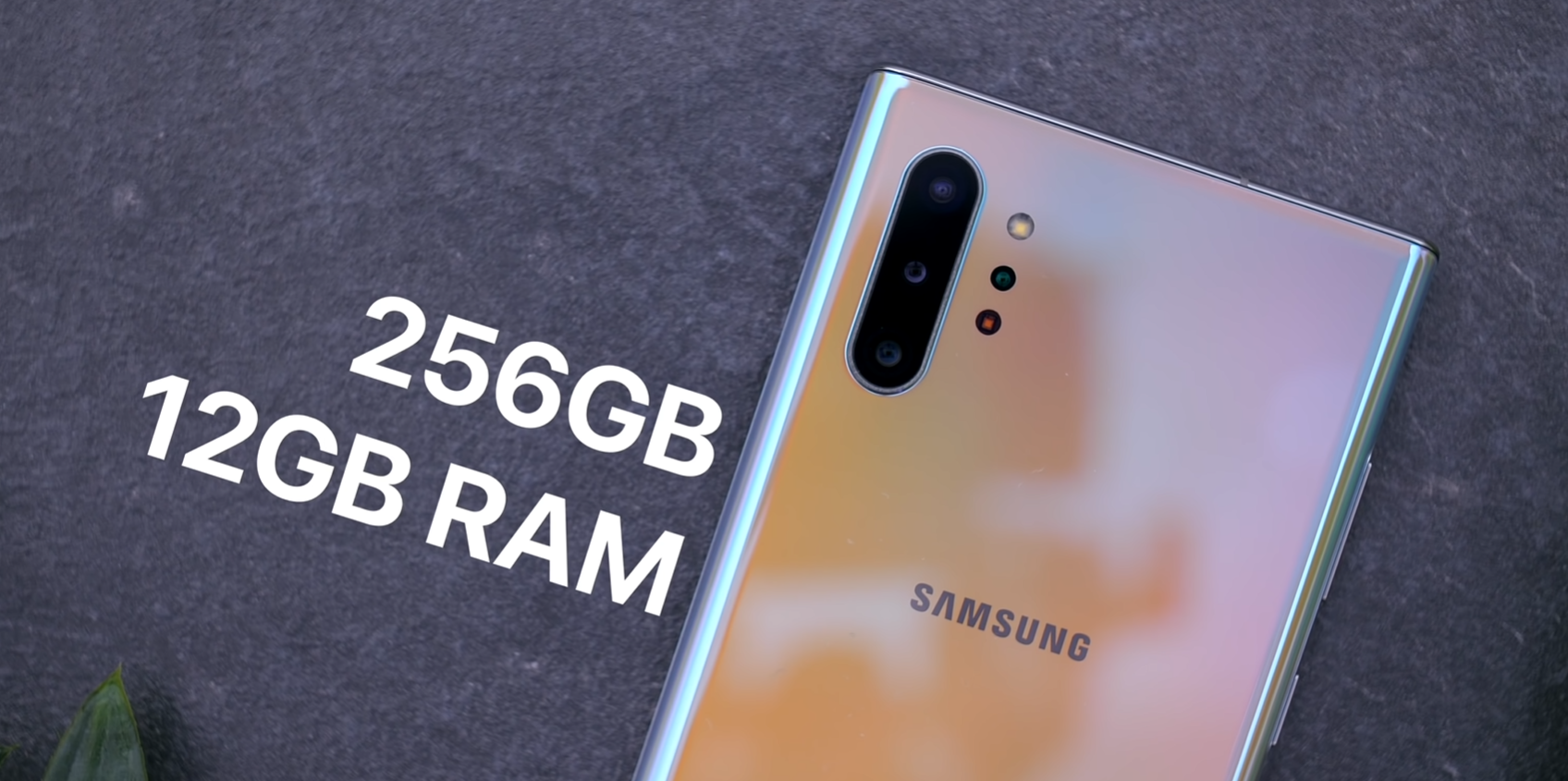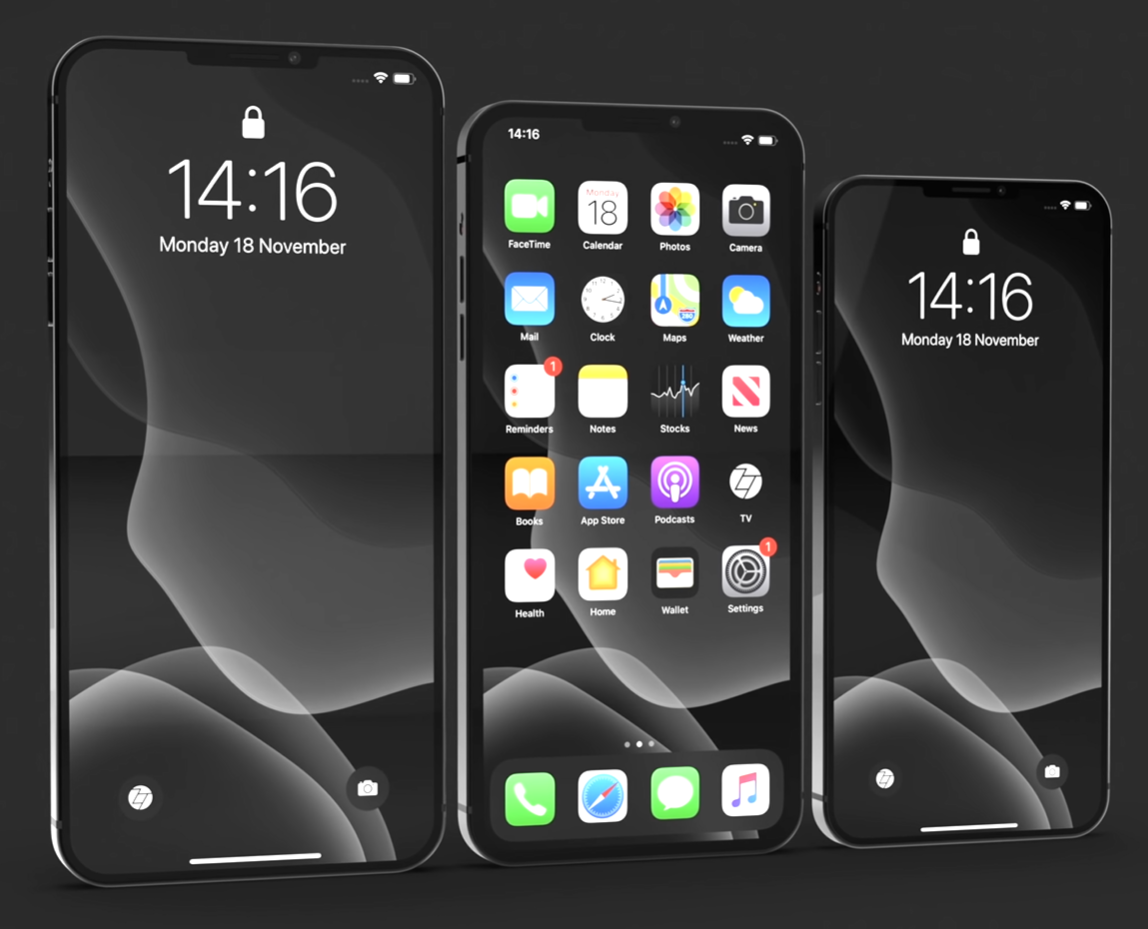The iPhone 11’s are now out, the reviews are in ours included and the iPhone 11 Pro Max that I’ve been using since September has been very good. The battery life has just been outstanding, the camera is great. I really don’t have any complaints at all, aside for the fact that we have the same design as on the 2018 iPhone XS and 2017 iPhone X.
This is the iPhone that we’ll have until September 2020, meaning that for the past 3 years, Apple hasn’t made any design changes to their iPhones at all, at least not from the front.
But the 2020 iPhones will be one of the biggest changes yet and they will feature a brand new design this time, so considering that I haven’t talked about the 2020 iPhones in a while now, here’s everything new you need to know!
The report on CNBC by JPMorgan Analyst, Samik Chatterjee where they predicted four new iPhones (Source: CNBC)
So the biggest leak in terms of the 2020 iPhone 12 (that’s just what we will call them for now) comes from JPMorgan analyst Samik Chatterjee, who claims based on information from supply chain sources, that Apple will be releasing four new iPhones in 2020, rather than three like they did in 2019 and 2018.
The smallest model would be a 5.4” iPhone, then we would have not one but two 6.1” iPhones and finally a massive 6.7” one. But which models would be the Pro’s? Well, Samik does report that one of the 6.1” models and that 6.7” model would both be Pro’s, while the 5.4” one and the other 6.1” iPhone would be lower entry models.
But then we have reports from Ming-Chi-Kuo, who’s had an outstanding track-record in the past, saying that Apple would only be releasing three iPhones in 2020. There would be one 5.4” model, one 6.1” model instead of two, and 1 6.7”. And the Pro models, according to Ming-Chi-Kuo, would be the 5.4” and the 6.7” variant.
Personally, I do think that the best approach for Apple would be to stick to just three models and offer the smaller and the bigger variants as Pro’s. This way, people who want to the performance and features of the biggest and most expensive iPhone that Apple offers can still get all of that in a much smaller form factor.
But according to pretty much every other report that we’ve seen, all four 2020 iPhones will now come with OLED displays. After so many years, we’ll finally get OLED on the entire lineup. However, the Pro models are still said to have a slightly more superior display, which is very likely to be the Pro-XDR display that Apple introduced with the iPhone 11 Pro’s, while the lower end models will likely have the iPhone XS’s display panel, which is still an OLED just not a bright and the 11 Pro’s display.
Samik also said that all the four iPhone models in 2020 will support 5G, which has also been confirmed by Nikkei. Qualcomm’s President Cristiano Amon, did say earlier this week at their conference that their number one priority of their Apple relationship is launching their 5G phone as fast as they can. So 5G will definitely be one of the main focuses of the 2020 iPhones. However, it seems like the 5G speeds would not be equal on all these iPhones, Smik did say in his JPMorgan report that the lower end non-Pro iPhones will be limited to sub-6GHz 5G networks, which would not support the mmWave 5G which is the fastest 5G available at the moment. Personally I don’t really see this as an issue at all, since 5G is still very limited to just a few cities and you need to have a 5G phone plan as well.
The new 0.25mm capacitors being produced by Murata Manufacturing (Source: MacRumors)
Also, speaking of 5G Nikkei reports that Murata Manufacturing, which is already a supplier for Apple, will start mass producing new tiny capacitors that take one fifth of the space of the current capacitors but offer ten times the electrical storage capacity. They’re absolutely tiny, at 0.25mm and by Apple using these capacitors it would allow them to free up some more space inside their iPhones, for those 5G antennas, which would indeed require some extra space.
Ok, what else? Well, Barclays analyst Blayne Curtis reported that he and his associates travelled to Asia recently to meet with manufacturers within Apple's supply chain and based on the information that he received it seems that both the iPhone 12 Pro and the 12 Pro Max will feature 6GB of RAM, up from the 4GB that the iPhone 11 Pro’s had, while the lower end models are still expected to come with 4GB of RAM. This is a bit disappointing because I’ve personally had RAM management issues with the iPhone 11 Pro Max, so that one should have definitely been upgraded to 6GB of RAM and then 8GB in the 2020 iPhones, but it seems like Apple will once again be behind in terms of RAM.
Some Android phones like the Note 10+ come with 12GB of RAM compared to the proposed 6 for the 2020 iPhones
Some Android phones today even have 12GB of RAM and yes, it’s not about the amount of RAM, it’s about how optimised a phone is to deal with that amount of RAM. Like I said, with 4GB of RAM I am having issues with my 11 Pro Max, even after the recent updates. Hopefully 6GB will solve that, but why not give it 8 Apple, just to be safe?
Barclays also reports that the two Pro models of the iPhone 12 will indeed feature a 3D time-of-flight camera. This is something that we’ve seen reported before by Ming-Chi-Kuo, back in July 2019. A TOF camera is essentially two small extra modules that include an IR receiver and an IR transmitter. The IR transmitter will beam a ray of IR light which will reach and object, bounce back and the IR receiver will calculate the distance between the camera and the object, based on the amount of time it takes for the IR light to be reflected back. This will allow the camera to map 3D objects in real time. This is actually how the FaceID camera maps your face as the FaceID camera on the front is already a TOF camera.
So we’ll pretty much be getting the same thing on the back, which will have a noticeable benefit in AR apps. This means, significantly improved tracking which is already very good, and also the ability to scan objects or even small rooms possibly in 3D. It is likely to be something similar to what the Samsung Galaxy Note 10+ can already do. Mark Gurman from Bloomberg has indeed detailed a road map of Apple’s AR and VR future, saying that they will be releasing a new iPad Pro in the first half of 2020, with this new 3D sensor followed by new high ends iPhones in late 2020 with the exact same cameras.
Also, speaking of the new iPad Pro 2020, Sony Dickson sent over a model of that upcoming iPad and we’ve even made a separate hands-on video with that, which you can watch here.
Ok, so we’re getting 5G, the camera is getting another module with 3D TOF capabilities, we’re getting more RAM and possibly four rather than just three models. But what changes are we getting design wise?
Well, we’ve had many contradictory reports on this, from all the major sources. Some are saying that Apple will remove the notch entirely, and switch to an In-Display fingerprint reader, some are saying that they will actually use both, and that FaceID will now be included into the top bezel, so no notch, just a thicker bezels surround the phone, and some are saying that we’re still getting FaceID, just with a smaller notch.
The ZONEofTECH Concept for the 2020 iPhone
Personally, I don’t see Apple removing FaceID that quick. They’ve spent so much time perfecting it, and we also have Animoji’s and apps that are using the 3D depth tracking capabilities of the FaceID camera on the iPhones. I do believe the reports however, that are pointing towards the notch being made thinner and smaller and that is how we’ve actually modelled our concepts, which I actually think look really good!
Now, the second design change which is something you’ve probably already noticed from our concept, is the frame of these iPhones.
Rather than this being that rounded shape that iPhones have had since the iPhone 6 in 2014, the 2020 iPhones are rumoured to bring back that old iPhone 4 look, with a more square off frame. The iPad Pro 2018 brought this design back, so we’ve actually modelled our concepts based on the iPad Pro 2018’s frame and I’m absolutely in love with how it looks! The iPhone 4 was by far my favourite design of any phone and this seems to top even that.
And Korean website TheElec, reports that Apple will be using LTPO displays for the 2020 iPhones. The same technology that Apple is now using in the Apple Watch. This will allow to iPhones to have a variable refresh rate, which could go down to even 1Hz, again, just like on the Apple Watch Series 5. This means that the 2020 iPhones could finally be getting an Always-On Display, something that we’ve had on Android phones for many years now and this has been one of my favourite feature ever in a phone. Being able to see the time and your notifications on screen all the time without having to unlock the phone is just amazing! Apple did add wireless charging to the iPhone X and 8, again a feature that was available on Android phones for years, and now there’s finally a very likely possibility that they’ll also add an always on display.
But this display could be more than just what the Apple Watch Series 5’s display is, which can go from 60Hz, to as low as 1Hz. You see, the iPad Pro’s have something that’s a bit better. They have 60Hz panels that can go as high as 120Hz and as low as 24Hz. They’re called a ProMotion display and I believe that this is what Apple would be including in the 2020 iPhones, at least on the Pro’s. Many smartphones today have started including 90Hz refresh rate displays, some even 120Hz, which make the entire UI experience 50-100% more fluid than what we currently have now. IceUniverse, a very well known leaker at this point, reported that Apple is actually considering a switchable 60/120Hz refresh rate screen, for the 2020 iPhones and that they’re currently in discussion with Samsung and LG for this.
Apple Patents hinting towards a full-screen fingerprint reader (Source: AppleInsider)
And speaking of the display, here’s something interesting. Economic Daily News Taiwan, who do have a good track record, reported that Apple will be holding meetings with Qualcomm to discuss adding an in-display fingerprint reader to at least one of their iPhones. The reason this is interesting is because when we look back at Apple’s patents they show an iPhone using full screen TouchID, which is something that we do not currently have. Now Qualcomm has recently shown us their new generation of In-Display fingerprint reader, which is 17 times larger than the one on the Galaxy S10 and the Note 10. So it’s likely that they’re in talks with Apple, to turn that into possibly a full-screen fingerprint reader.
Then finally a very surprising report from DigiTimes Taiwan which was picked up by MacRumors, claims that Apple is actually considering bundling AirPods inside the box of the 2020 iPhones. Now, I’m a bit skeptical about this report but when the iPhone X came out, I even said in my full review, that for how much it costs, $1000, Apple should definitely bundle AirPods with this phone, but of course that they didn’t and the prices went up even more. With the introduction of the iPhone XS Max and 11 Pro Max and AirPods became even more expensive, with the 2nd gen and the AirPods Pro. So because of that, it seems to me like Apple’s prime motive is again, to make as much profit as possible, so bundling free AirPods inside the box? I just don’t see them doing that.
Now, this DigiTimes report did claim that smartphone vendors, including Samsung and Xiaomi, so not just Apple, are all considering bundling truly wireless headphones in the box of their upcoming phones. And I do see Samsung doing this, I really do. But Apple? I don’t think so. If they do do it, I don’t see them being the first ones on the market to do it. Probably in about two years time but maybe not even then.






